1. Features
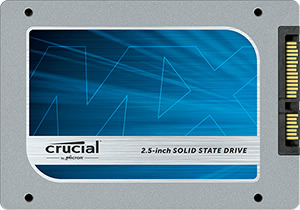 Crucial announced during last month's Computex the Crucial MX100, its new mainstream solid-state drive, brought to replace the
Crucial announced during last month's Computex the Crucial MX100, its new mainstream solid-state drive, brought to replace the
M500 series while the M550 will continue to serve the higher performance market.
The MX100 Crucial has been designed to offer lower in terms of price per gigabyte by utilizing Micron's 16nm 128Gbit MLC NAND - the smallest process node we have seen since Toshiba's introduction of their A19nm NAND. The smaller lithography translates into smaller transistor size, which in turn means that the same amount of storage can be fit into a die that is physically smaller.
The MX100 builds on the same architecture as the M500 and M550. Their basic difference is the NAND inside as the controller is the same Marvell 88SS9189 silicon as found inside the M550. The 9189 is an upgrade over the 9187 but all it brings is a better support for DevSLP along with some bandwidth optimizations.
Other than performance, Crucial is bringing some differentiation by offering limited capacities as the MX100 will only be available at up to 512GB.
Here are the specs:
| Capacity |
128GB |
256GB |
512GB |
| Controller |
Marvell 88SS9189 |
| NAND |
Micron 16nm 128Gbit MLC |
| Sequential Read |
550MB/s |
550MB/s |
550MB/s |
| Sequential Write |
150MB/s |
330MB/s |
500MB/s |
| 4KB Random Read |
80K IOPS |
85K IOPS |
90K IOPS |
| 4KB Random Write |
40K IOPS |
70K IOPS |
85K IOPS |
| Endurance |
72TB (~65GB/day for 3 years) |
| Encryption |
AES 256-bit, TCG Opal 2.0 & IEEE-1667 |
| Warranty |
Three years |
As you are seeing above, the use of 128Gbit NAND results to a performance hit at smaller capacities. As the higher capacity per die means that fewer die are needed to achieve a certain capacity, parallelism is reduced, which is the key of SSD performance.
Feature wise the MX100 matches the M500 and M550. Both power loss protection and hardware encryption (including TCG Opal 2.0 and IEEE-1667 standards) are supported and the endurance rating remains at the same 72TB. RAIN (Redundant Array of Independent NAND) is also included to protect against page/block level failures and the parity ratio remains at 127:1 similar to the M550.
2. Package, installation
The Crucial MX100 retail package of the 512GB version of the drive we will test today is shown below:

The drive is packaged in a standard 2.5-inch 7mm z-height enclosure.

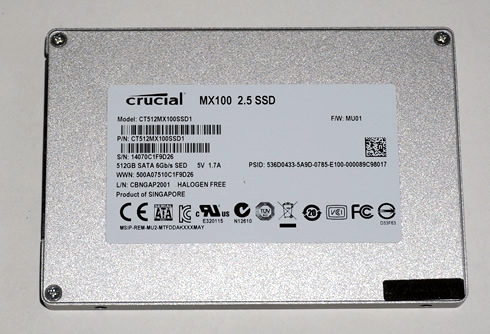
To deal with NAND error rates and defects, which are more prevalent at 16nm, Crucial used the RAIN (Redundant Array of Independent NAND) support to the MX100. But in order to save space for RAIN, Crucial is allocating almost 14% of the NAND area, used to curb failure due to NAND defects.
As we previously mentioned, the Crucial MX100 utilizes 128Gbit per die NAND. That allowed Crucial to go higher than 512GB without sacrificing performance but also meant a hit in performance at the smaller capacities.
The drive came with firmware Ver. MU01 installed and as you see below, the available capacity for the user is 488.386 MB (512GB drive). The difference is mostly the conversion of GB to GiB plus a bit of space set aside for over provisioning that the controller uses to maintain the drive over time in an effort to mitigate performance degradation.
The readout on CrystalDiskInfo shows that both NCQ and S.M.A.R.T. are enabled, as well as TRIM and the interface is confirmed at SATA 6Gbps:


3. HDTachRW, HDTune
Here is our testbed:
- Motherboard: Foxconn Quantum Force Rattler P67 vP04 BIOS
- Processor: Intel Core i5-2500K
- Case: Open Air testbed
- Power Supply Unit: Club 3D CSP-X1000CB 1000 Watt
- Graphics card: Club3D Radeon HD 6790 CoolStream Edition
- Memory: OCZ Gold PC3-10600 4x2GB 1333@CL9
- HDD: WD 500GB 7200RPM
- Monitor: LG L246WH-BH 24"
- Windows 7 x64 SP1 with latest updates installed
For the tests, we used the following software:
- HDTachRW v3.0.1.0
- HD Tune v4.50 Pro
- Crystal DiskMark v3
- ATTO Disk Benchmark v2.46
- ASS SSD Benchmark 1.5xxx
- IOMeter v2006.07.27 with Xtreme Benchmark template
- PCMark Professional edition v1.04
- Anvil Storage Utilities 1.0.34. Beta 11
We start the tests with the HDTachRW software.
The software measures the sequential read speed, the random access speed and sequential write speed.
The drive gave 299.3 MB/s and 435.3 MB/s on average for sequential reads and writes, respectively. The performance is pretty close to what we had experienced with the previous Crucial SSD, the M550:


We move on to the HD Tune Pro software, another utility we used to measure the drive's reading and writing performances. Although not necessarily representative of real-world workloads, HD Tune's targeted tests give us a glimpse of each drive's raw capabilities.
This time the sequential reading test returned a 214.5 MB/s average speed and the corresponding sequential writing test a 185.2 MB/s average, which are both lower than we expected:

As you see in the screenshot below, writing was not stable across the data sequence and the reading speed was slow after the 153MB mark of the graph, resulting to a low overall average writing speed:
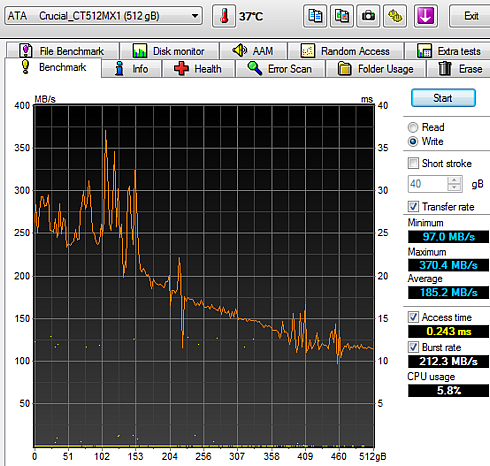
HD Tune's file benchmark consists of two parts: the transfer speed test and block size test.
The transfer rate test measures three different parameters for both reading and writing:
- Sequential: the sequential speed is measured and shown on the graph. Ideally the transfer
speed line should be straight and smooth.
- 4 KB random single: this test measures the performance of I/O operations of 4096 byte blocks - the most common I/O operation on a typical system. Especially the 4 KB write speed is
an important indication of general system performance.
- 4 KB random multi: this test is similar to the 4 KB random single test except that multiple
requests are sent simultaneously to the device. We set the number of operations to 32.
Below you see random reading test, where the MX100 gave a 489.017 MB/s average reading speed for an 1MB transfer size and a 466.07 MB/s average reading for transferring files with random sizes - a pretty good performance, again almost in par to what we had experienced with the M550 SSD.

HD Tune's file benchmark also features three data patterns available that can be used during the write process: zero, random and mixed, which is a combination of zeroes and random data. Certain
SSDs use a compression technique which improves performance when compressible data is
used.
For these devices the results will be highest when writing zeroes and lowest when writing
random data.
Let's start with a sequential transfer speed of a 500MB file using zeros in the writing part:

The Crucial MX100 drive read the 500MB file at an average speed of 498.10 MB/s and wrote the file at 479.42 MB/s - pretty fast in both cases. The 4K random single performance with 4096 byte blocks was 7657 IOPS for reading and 19972 IOPS for writing, which are also fast, although the writing part was a little slower than what we had seen with the M550 model. When we enabled the 32 requests option, both figures were boosted up to 37122 IOPS and 84807 IOPS for both read/write, respectively.
Selecting the "Random" data pattern (zeroes and data) had not any serious impact to drive's sequential read performance:

The reading result with a "mixed" data pattern was also very high.
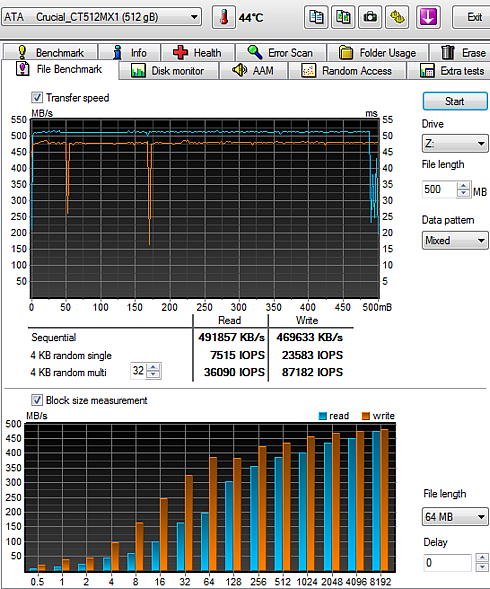
Below you see some additional sequential and random reading and writing tests:


4. ATTO Disk Benchmark
The next software we used was the ATTO Disk Benchmark. The tool measures storage systems performance with various transfer sizes and test lengths for reads and writes. The benchmark performs file transfers ranging from 0.5 KB to 8192 KB. ATTO can be adjusted to do overlapped I/O, in a variety of queue depths. We tested the SSD using the benchmark's default settings, using 256KB file length performance and QD4. ATTO probably gives the most accurate results for compressible read and write data.
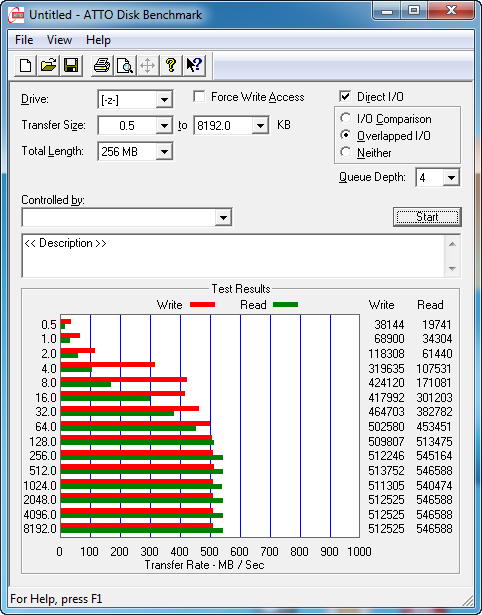
As you see above the drive's reading and writing performance with compressible files was pretty stable with files larger than 128KB. The average reading speed was about 520 MB/s and the writing speed was 480 MB/s.
However, the MX100 drive is suffering a bit in the sequential reading of 4KB or smaller files -- an issue also met when we tested the M550 SSD:

On the other hand, the Crucial MX100 drive was fast when it was writing such small, compressible files:
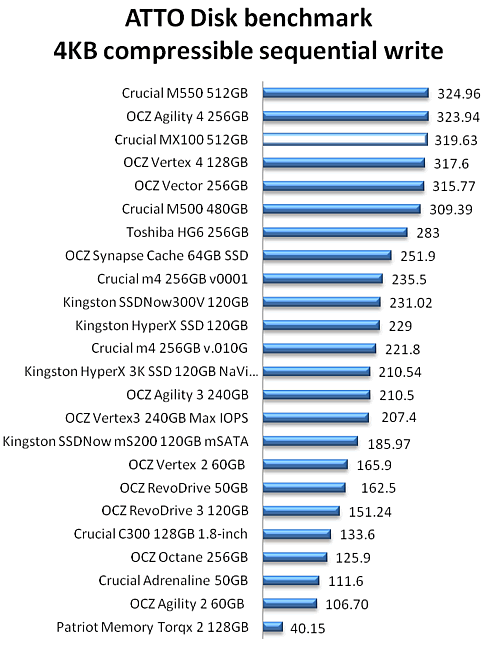
Going further to larger file transfers, the MX100 drive remained fast, especially in the reading part:

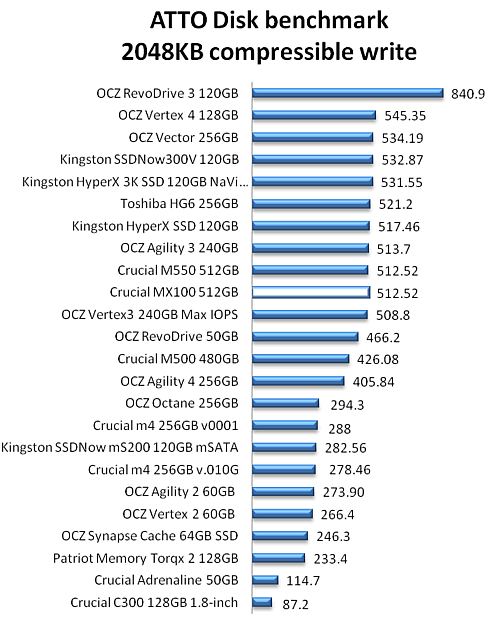
5. CrystalDiskMark
The next benchmark is the CrystalDiskMark. The software provides throughput data based on sequential reads and writes, and random (512K/4K/4KQD32) reads and writes of various sizes.
Below you see the drive's performance with incompressible (0Fill) data:

As you see below, the MX100 continues Crucial's tradition to offer SSDs that perform the same no matter if the stored/retrieved data is compressible or not:

As we previously saw, the Crucial MX100 512 GB SSD will perform according to its official specs in the sequential reading and writing tasks. The drive also reads and writes 512K files fast, and remains fast enough in the random read/writes of small 4K files:


6. AS SSD benchmark
We move on with the AS SSD benchmark, which contains five synthetic as well as three practical tests. The synthetic tests determine the sequential and the random read / write performance of an SSD. These tests are carried out without using the operating system's cache. The Seq-test measures how long it takes to read and write an 1GB file. Most importantly, this sequential benchmark uses incompressible data for all of its transfers.
The 4K benchmark tests the read and write performance for random 4K blocks. The 4K-64-THRD-test corresponds to the 4K procedure except that here the read and write operations are distributed on 64 threads:


The MX100's performance in sequential reading with incompressible test was high enough (516.53 MB/s), almost matching the performance quoted by Crucial. The same applies for sequential writing, where the drive wrote the incompressible files at 477.59 MB/s (average).
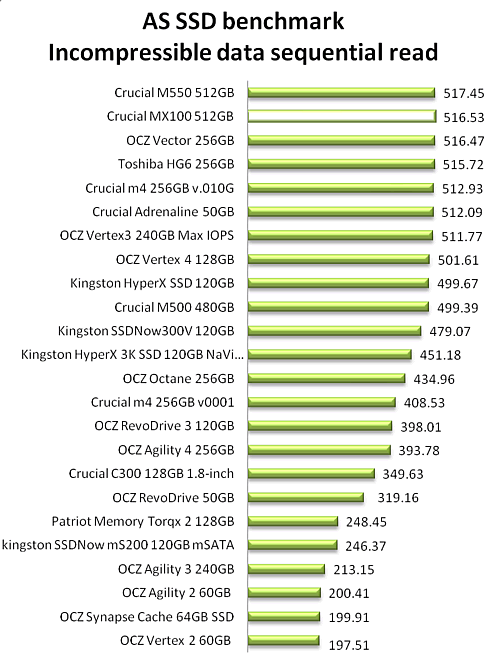
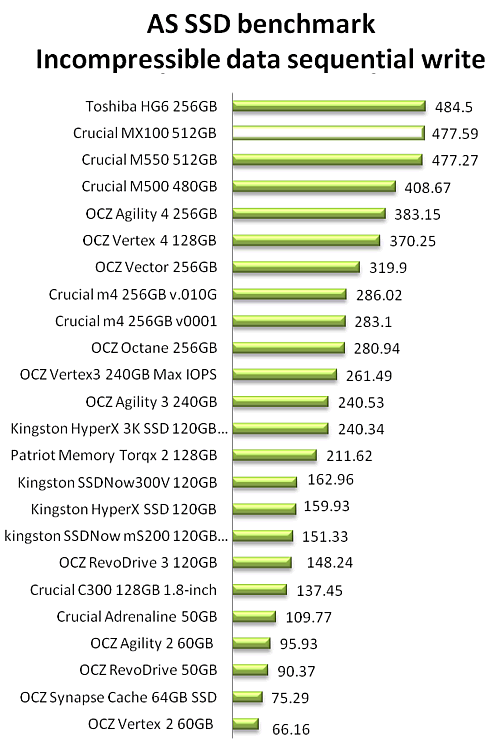
At the 4K random reading tests, the Crucial MX100 512GB took to the top of the chart below, with an average reading speed of 28.42 MB/s.

The drive also excelled in the 4K random writing tests with 90.86 MB/s:

Multi-threaded requests for random reading of 4K incompressible files were not an issue for the MX100 SSD., although this time the drive was slower than the M550 / M500 and the Toshiba HG6 256GB SSDs:
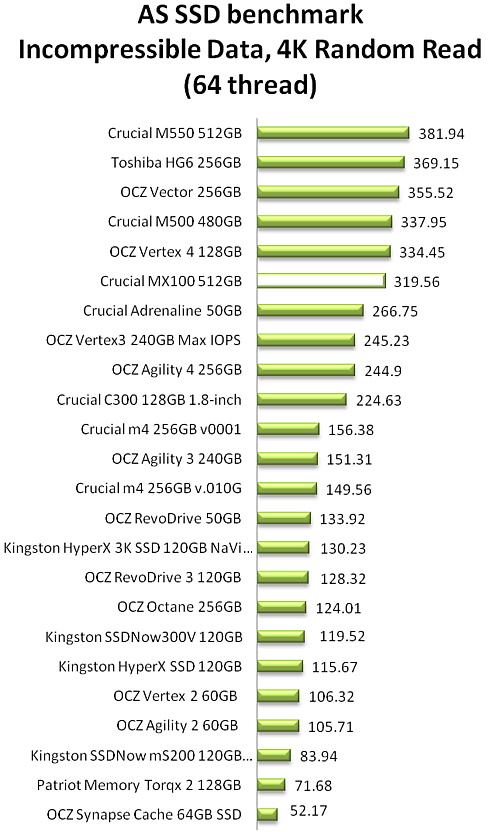

In the following graph you see how the MX100 512GB drive reads and writes files, which have been partially of fully compressed. It is obvious that the both reading and writing speeds do not depend on level of file compression:

7. IOMeter
This is the IOMeter benchmark. Iometer is run by using workstation and database patterns for queue depths (outstanding I/Os) representing very light and moderate loads. Iometer is both a workload generator (that is, it performs I/O operations in order to stress the system) and a measurement tool (that is, it examines and records the performance of its I/O operations and their impact on the system). The app's ability to bombard drives with an escalating number of concurrent IO requests also does a nice job of simulating the sort of demanding multi-user environments that are common in enterprise applications. The software can be used for measurement of the performance of an SSD. We started using the IOMeter tests using the Xtreme Benchmark template .
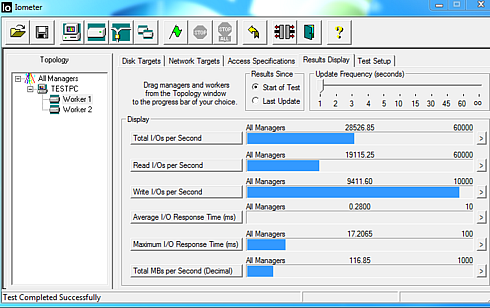
For the specific test, we used 100% random, 67%-33% Read/write distribution, aligned with the benchmarks we had already done in the past with other SSDs.
The Crucial MX100 512GB SSD was close to the top in the total I/O chart, although it was slower than the Toshiba HG6 256GB drive, mainly in the writing part:



8. Anvil Pro
The next benchmark is the Anvil Pro, an ‘all inclusive’ storage utility. The software is tests transfer speeds as well as IOPS The IOPS tests can be configurable with preset testing scenarios for read (Seq 4MB, 4K, 4K QD4, 4K QD16, 32K and 128K), write (Seq 4MB, 4K, 4K QD4, 4K QD16) and mixed IO.
We used the software with the Crucial MX100 512GB SSD and tested the drive with 0-fill compression (RAW), 8% compression, 25% compression, 45% compression, 67% compression and finally 100 % (incompressible data). Below are the results with 0-fill compression as well as with fully incompressible files.

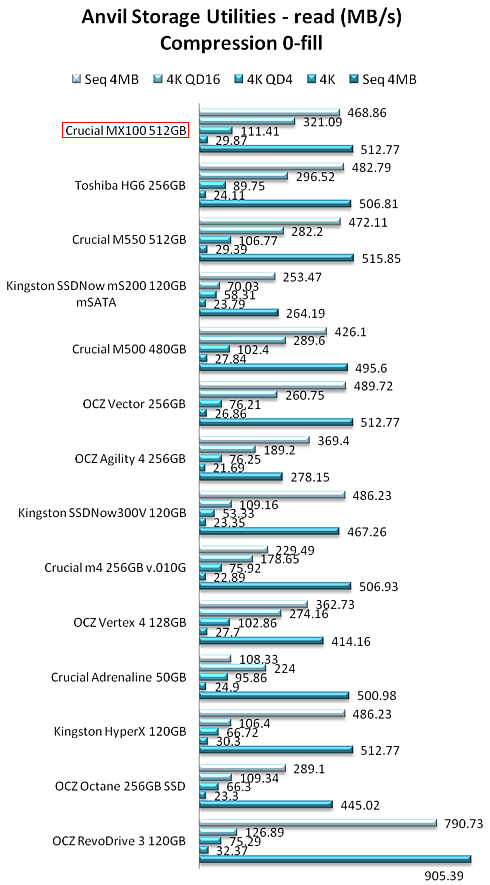
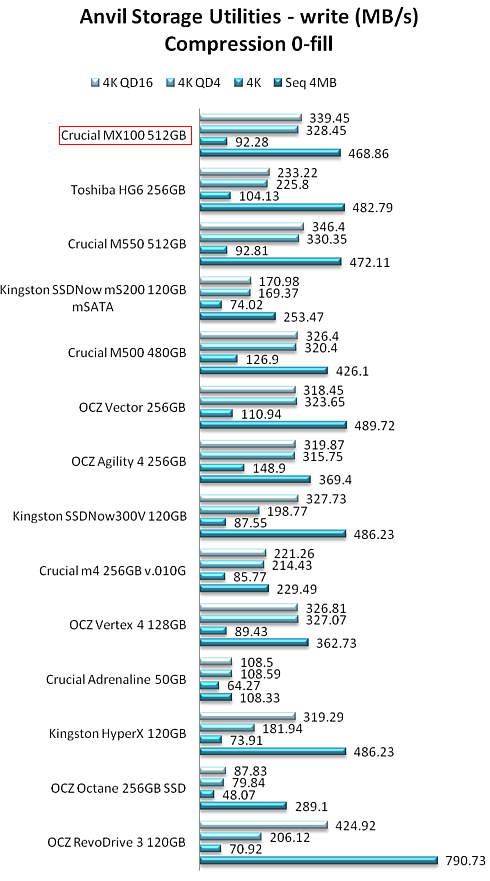



9. PCMark 7, PCMark 8
Below you see the results of Futuremark's PCMark 7 Professional edition. The software includes 7 PC tests for Windows 7, combining more than 25 individual workloads.
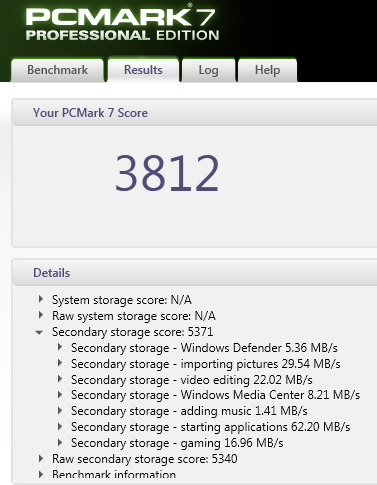
Below you can see the breakdown of individual benchmarks with the testing methodology. The Crucial MX100 512GB drive scored 5371 points at the storage benchmark, while it also maintained high performances in the corresponding sub-tests:

We continue with the PCMark 8 Storage benchmark, which uses traces recorded from Adobe Creative Suite, Microsoft Office and a selection of popular games. Unlike synthetic storage tests, the PCMark 8 Storage benchmark highlights real-world performance differences between storage devices.
The Crucial MX100 SSD scored 4986 points, pretty close to the Toshiba HG6 256 GB and the M550 512GB SSDs:



10. Final words
Obviously, the MX100 is a great replacement for the M500, as it proved to offer the same - even a bit higher in some cases - performance, the same features at a lower the price by using smaller lithography NAND.
But the basic advantage of the MX100 is its price/GB. You can buy the 256GB version for $115, and the 512GB at less than $215. Both prices are extremely low for the competition and we should expect to see a response from other SSD makers.
We find it hard to list any negative for the MX100. With the performance and feature set, combined with pricing, the choice is obvious, unless you are an enthusiast or professional with a heavy IO workload.
Models (2.5-inch) |
Online prices |
|
$75 |
|
$115 |
|
$213 |